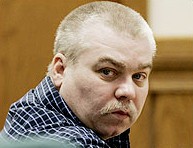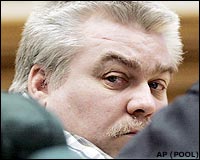CHILTON, Wis. — Advanced DNA testing was used to free Steven Avery after he spent 18 years in prison for a rape he didn't commit; now the same technology threatens to put him in prison for the rest of his life.
Avery, 44, is accused of luring Teresa Halbach, a young photographer working for Auto Trader Magazine, to his family's auto salvage yard, where he allegedly killed her and mutilated her remains on Halloween 2005.
Bone fragments and tissue found in a burn barrel outside Avery's mobile home matched Halbach's DNA profile, according to police.
If convicted of murder, Avery faces life in prison.
The irony of Avery's situation has drawn nationwide attention and brought a throng of media outlets to Chilton, Wisconsin. In this town of approximately 4,000, Avery became a notable figure after becoming one of the first subjects of the Wisconsin Innocence Project to walk free.
The Innocence Project, headed by the University of Wisconsin Law School, uses DNA technology to help free wrongly convicted prisoners.
The sophisticated DNA testing used to identify Halbach was in its infancy in 1985, when Avery was convicted of sexual assault. In 2003, DNA evidence indicated that another man — who was already in prison — had committed the crime that put Avery away for nearly two decades.
But the time Avery spent in prison doesn't matter in Halbach's case, according to special prosecutor Kenneth Kratz.
"Who killed her?" Kratz said during his opening statement Monday. "This evidence points to one person."
Kratz told jurors that Avery called Auto Trader Magazine and requested that Halbach, who had been to the salvage yard before, stop by to photograph a Dodge Caravan his family was selling. Sellers normally pay $40 for the pictures to be taken. The photographers receive a cut of the fee.
Three days after Halbach visited the salvage yard, her family reported her missing.
After contacting the publication, investigators zeroed in on Avery's property — a sprawling 40-acre site muddled with rusting and mangled cars. Avery lived in a trailer on the property where his parents, sister and brothers also lived in a string of mobile homes.
After searching every trunk of the 4,000 cars located on the lot, police found no evidence of Halbach until two volunteers found her Toyota RAV 4 parked along the perimeter of the lot, Kratz said. The car's license plates were missing.
Over the next 11 days, police found Halbach's charred remains in a burn barrel along with her cellphone situated a stone's throw from Avery's trailer. Inside his home, investigators located Halbach's car key covered with the defendant's blood. Her crumpled license plates turned up in an aging station wagon.
When the forensic testing was
completed, investigators matched Avery and
Halbach's blood to that found inside her SUV.
Other trace amounts of Halbach's DNA were found
on a bullet embedded in the floor of Avery's
garage, according to Kratz.

Teresa Halbach, the victim
Defense attorney Dean Strang does not dispute the evidence — the bullet with Halbach's DNA, the blood found in her car, or the key smeared with Avery's blood. Instead, Strang concludes that these were planted by police.
A plot engineered by law enforcement may seem like a desperate argument, but Strang offered a motive. Two officers — Sgt. Andrew Colborn and Lt. James Lenk — were forced to give depositions in a $36 million lawsuit Avery filed against Manitowoc County, where he was wrongly convicted.
"All of those turning emotions, all of that within the Manitowoc County Sheriff's Department floods out. You can call it tunnel vision, you can call it investigative bias, but this investigation is about Steven Avery and not much else," Strang said in his opening statement.
Infuriated by the embarrassment of the lawsuit and unjust conviction, they went after Avery, according to Strang.
"This wasn't an effort to frame an innocent man. It was an intense desire to conclude that he was the guilty man," Strang told jurors.
The defense attorney claims an unprotected vial of Avery's blood, which was taken during the review of the 1985 case, provided the means for the officers' deception.
The officers dabbed the defendant's blood in the victim's car, on the car key and on the bullet, according to Strang.
Why else wouldn't investigators have found Halbach's key lying in plain sight in Avery's bedroom after several exhaustive searches of his home? Strang asked.
Lenk did not find the car key until eight days after Halbach disappeared, according to Strang. And it did not have any of the victim's DNA or fingerprints on it.
The bullet that tested positive for Halbach's DNA was not recovered until five months after her murder, according to the defense. Despite several searches that turned up other bullets and shell casings in the garage, the incriminating one wasn't found until March 2006.
The defense also raised questions over the bone fragments found near Avery's trailer. Strang said other fragments were found in the gravel pits that surround the salvage yard, but were not entered into evidence because they were too badly destroyed to be linked to Halbach.
Strang contends the bones were moved from another site to the burn barrel where police recovered them.
"If he's the one that burned the body, he's not going to bring [the bones] back 20 yards outside his bedroom window," Strang said.
Avery is charged with first-degree
intentional homicide, false imprisonment,
Testimony is expected to continue tomorrow in the trial, which is slated to last six weeks.


